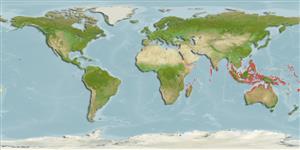>
Ovalentaria/misc (Various families in series Ovalentaria) >
Pomacentridae (Damselfishes) > Pomacentrinae
Etymology: Neopomacentrus: Greek, neos = new + Greek,poma = cover, operculum + Greek,kentron = sting (Ref. 45335).
More on author: Bleeker.
Environment: milieu / climate zone / εύρος βάθους / distribution range
Οικολογία
Θαλασσινό(ά); Γλυκού νερού; Υφάλμυρο βενθικό(ς); εύρος βάθους 0 - 3 m (Ref. 7247). Tropical; 23°C - 28°C (Ref. 12468); 19°N - 21°S
Indo-West Pacific: East Africa to Indonesia and the Solomon Islands, north to the Philippines, south to northern Australia and Vanuatu. Reported from Taiwan (Ref. 5193).
Μέγεθος / Βάρος / Age
Γεννητική Ωρίμανση: Lm ? range ? - ? cm
Max length : 10.0 cm TL αρσενικό/απροσδιόριστο; (Ref. 48636)
Short description
Κλείδες προσδιορισμού | Μορφολογία | Μορφομετρία
Ραχιαίες άκανθες (συνολικά) : 13; Μαλακές ραχιαίες ακτίνες (συνολικά) : 11 - 12; Εδρικές άκανθες: 2; Μαλακές εδρικές ακτίνες: 11 - 12.
Body shape (shape guide): fusiform / normal; Cross section: compressed.
Adults inhabit mangroves, estuaries, lower reaches of freshwater streams, and harbors with freshwater discharge. Also found in pure fresh water, but always within a few kilometers of the sea (Ref. 2847). They occur in brackish waters of coastal embayments and mangrove estuaries (Ref. 44894). Spawning may take place in both brackish and fresh waters (Ref. 2847). Oviparous, distinct pairing during breeding (Ref. 205). Eggs are demersal and adhere to the substrate (Ref. 205). Males guard and aerate the eggs (Ref. 205). Diurnal species (Ref. 52881).
Life cycle and mating behavior
Γεννητική Ωρίμανση | Αναπαραγωγή | Γεννοβολία | Αβγά | Γονιμότητα | Προνύμφες
Oviparous, distinct pairing during breeding (Ref. 205). Eggs are demersal and adhere to the substrate (Ref. 205). Males guard and aerate the eggs (Ref. 205).
Allen, G.R., 1991. Damselfishes of the world. Mergus Publishers, Melle, Germany. 271 p. (Ref. 7247)
IUCN Red List Status (Ref. 130435: Version 2025-1)
Threat to humans
Harmless
Human uses
αλιεία: περιορισμένης εμπορικότητας
Εργαλεία
Special reports
Download XML
Διαδικτυακές πηγές
Estimates based on models
Preferred temperature (Αναφ.
123201): 26.8 - 29.3, mean 28.7 °C (based on 2180 cells).
Phylogenetic diversity index (Αναφ.
82804): PD
50 = 0.5000 [Uniqueness, from 0.5 = low to 2.0 = high].
Bayesian length-weight: a=0.01479 (0.00651 - 0.03363), b=3.00 (2.81 - 3.19), in cm total length, based on LWR estimates for this (Sub)family-body shape (Ref.
93245).
Τροφικό Επίπεδο (Αναφ.
69278): 3.4 ±0.45 se; based on food items.
Ελαστικότητα (Αναφ.
120179): Υψηλό, ελάχιστος χρόνος για διπλασιασμό πληθυσμού < 15 μήνες (Preliminary K or Fecundity.).
Fishing Vulnerability (Ref.
59153): Low vulnerability (10 of 100).
🛈
Nutrients (Ref.
124155): Calcium = 364 [206, 917] mg/100g; Iron = 1.72 [1.04, 3.06] mg/100g; Protein = 18.3 [17.3, 19.3] %; Omega3 = 0.225 [0.113, 0.453] g/100g; Selenium = 19.5 [9.3, 44.0] μg/100g; VitaminA = 63.1 [22.5, 175.6] μg/100g; Zinc = 2.16 [1.43, 3.28] mg/100g (wet weight);
